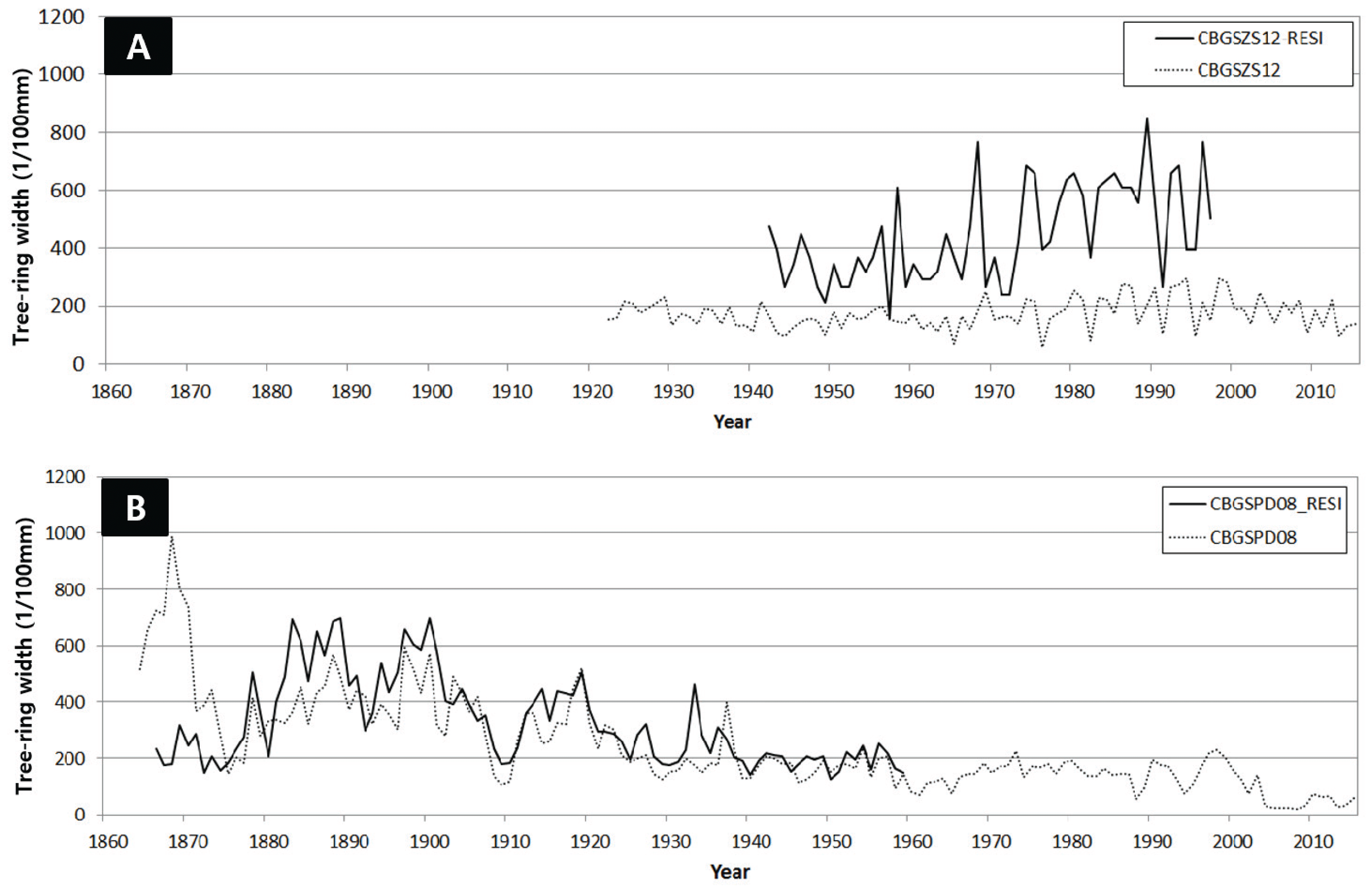1. INTRODUCTION
Since ancient times till now, the people of many villages in South Korea offer sacrifices to big old trees, usually located at village entrances for the peace of their villages (Heo et al., 2011). The places, where the big old trees are, have also been used as public spaces where all the villagers gather to perform various local events (Ahn & Choi, 2001; Jeong & Yoon, 2014; Jung & Kim, 2017). Therefore, big old trees have historical and cultural values. Based on these cultural values of big old trees, national and local governments established the Forest Protection Act (Article 13, designation and management of the law-protected trees) or an Ordinance to designate and manage the trees as a natural monument or law-protected trees.
Tree age is one of the important parameters to evaluate the historical and cultural values of big old trees. For this reason, we tried to estimate the age as accurately as possible. There are three representative methods to investigate a tree’s age, viz. tree rings, nodes, and diameter (Son et al., 2007). The most accurate method of these three is to count the number of tree rings(Jeong et al., 2017; Seo et al., 2017a, b). Especially, the number of tree rings at the boundary between the root and stem represents the tree age (Park et al., 1987). However, it is almost impossible to investigate tree rings at the boundary without cutting the tree. Therefore, the tree age is normally investigated using increment cores extracted at breast height of the stem, and in order to estimate more precisely, the estimated year is added to the height growth from the ground up to the breast level (Wong & Lertzman, 2001).
Now, during sampling using an increment borer, wounding the stem cannot be avoided. Although this wounding does not impart a great effect on the tree growth and/or the life of the tree, we are reluctant to use an increment borer for sampling. Resistograph is an equipment designed to measure the degree of wood decay, cavities, and crack (Frank, 1994, 2013; Gruber, 2000). The operation of a resistograph is based on electrical resistance It comprises an electronically controlled drill resistance which has a strong linear relationship with wood density (Frank, 2012). Conifer and ring porous trees in temperate zone show the lowest and highest densities in the early- and latewood within the tree rings, respectively (Schweingruber, 1988). Using the pattern of density variations measured by resistograph, we can investigate tree ages (Bilgin et al., 2012; Lukaszkiewicz et al., 2005). The greatest advantage of a resistograph in counting and/or measuring tree rings is that it makes smaller wounds (Ø 2 mm) than the ones by an increment borer (Ø more than 5 mm). In previous study, it was verified that resistograph can most perfectly measure tree-ring widths larger than 1 mm (Oh et al., 2019).
Decay within trees is one of difficulties in investigating tree ages. Most big old trees are partially decayed and the decayed locations are variously distributed within the stems. Due to such conditions, it is difficult to obtain continuous tree rings from the bark to the pith, and therefore, it is a challenge to measure the innermost tree ring, which is the most important reference in determining the tree age. In dendrochronology, dating is done by comparing an undated tree-ring time series with a dated long tree-ring time series (master chronology), which is called ‘cross-dating’ (Schweingruber, 1988). This method can be used to identify the logging year of the timber, to date wooden artifacts excavated at the site(Lee et al., 2018), and to track the origin of the timber(Eckstein and Wrobel, 2007). If we have longer than around 50-year time series with the inner most tree ring, the inner most tree ring can be dated by the cross-dating method. Oh et al. (2017) established the master chronology of Pinus densiflora and Zelkova serrata for the provinces of Goesan in Chungbuk, Gurae in Jeonna, and Uljin in Gyeongbuk in a previous report.
The current study explored the possibility of applying resistograph to establish the tree-ring time series of big old living trees (Pinus densiflora and Zelkova serrata) in Goesan based on the results of Oh et al. (2019), and then, to date the tree rings by comparing the time series with the master chronology established by Oh et al. (2017). We believe that the results of our study could be used as a practical reference in estimating the tree age using resistograph.
2. MATERIALS and METHODS
For the present study, ten big old trees from Goesangun in Chungbuk were selected of which 3 were Zelkova serrata and 7 were Pinus densiflora. These tree species occupy 52% (7,302 trees) and 13% (1,753 trees) of all the protected trees, respectively (Korea Forest Service, 2018). The mean diameters at breast height (DBH) of Zelkova serrata and Pinus densiflora are 102 (92-116) cm and 80 (65-110) cm, respectively (Table 1). The measurement heights from the ground using resistograph were between 1.2 and 4.3 m for Zelkova serrata, and between 0.6 and 1.1 m for Pinus densiflora.
Resistograph (IML-RESI PD400, Germany) was used to measure the tree-ring widths. By IML Australia ⓒ (2013), tree-ring boundaries can be clearly distinguished at electrical resistance range of 40-60% of the resistograph. In a previous study (Oh et al., 2019), it was suggested that the needle and feed speeds of resistograph should be decided by performing a pre-test field work. The measurement depth of the resistograph was 40 cm, which was actually the length of the needle (Fig. 1).
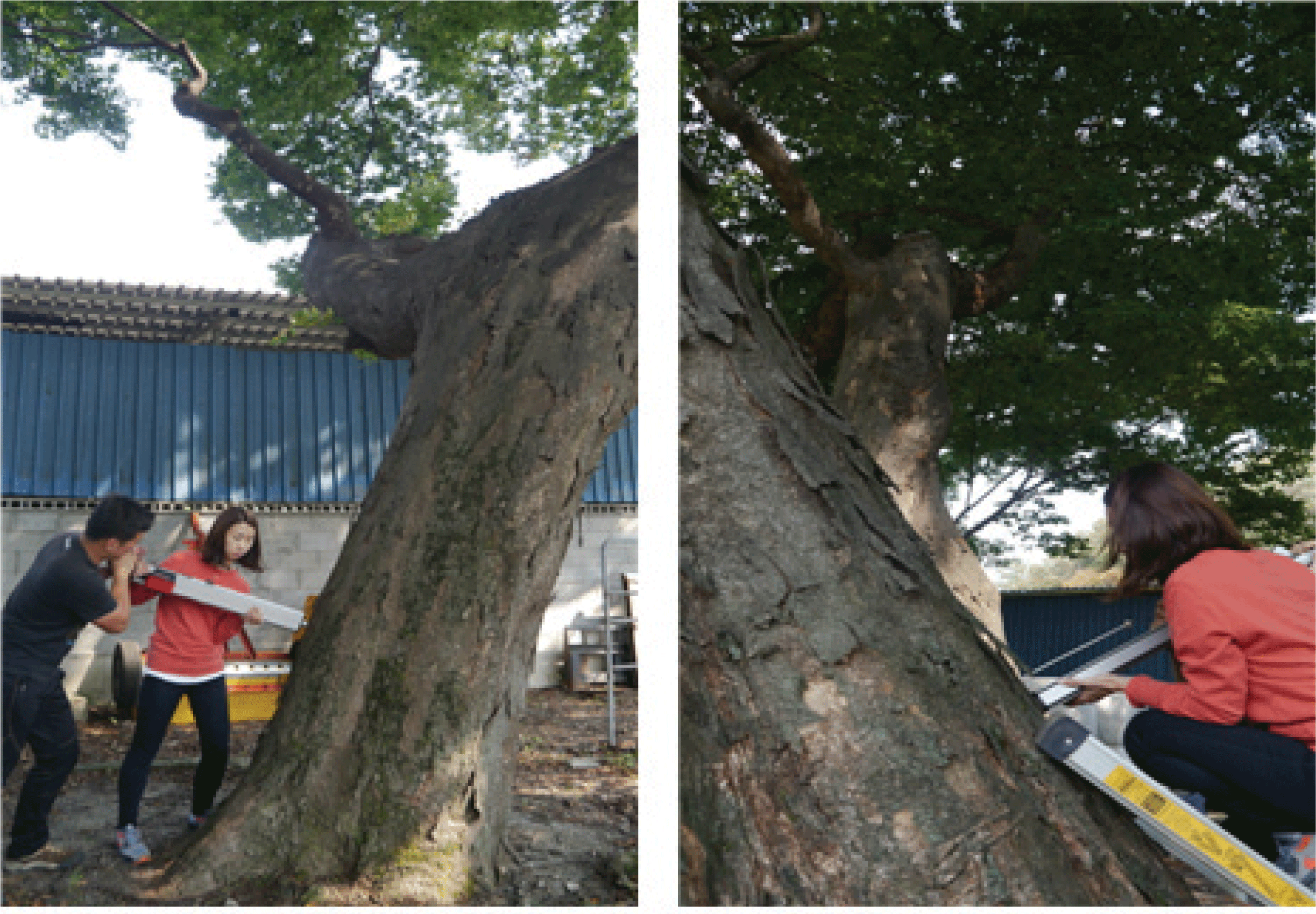
With respect to the current amplitudes of the resistograph from the bark to the pith in the stem of Zelkova serrata, the lowest part of the wave was considered as the tree-ring boundaries (Fig. 2), since the porous rings have the lowest wood density at the beginning of the tree rings where large pores were formed (Fig. 4A). Although the ring boundaries will somehow shift to the locations of the large pores in the next year, no calibration is necessary because such shifts occurred uniformly in all the tree rings. On the other hand, the tree-ring boundaries of Pinus densiflora were determined at the end of tree rings having the highest wood density and where latewood cells with small diameters and thick cell walls in the radial direction are present (Fig. 3). In this case, the boundaries were slightly shifted to the latewood in the current year due to same locations of the cells with the highest density within the tree rings (Fig. 4B) (Schweingruber, 1988). Similar to Zelkova serrata, the shifting effects did not require any calibration because such shifting were present in all the tree rings.


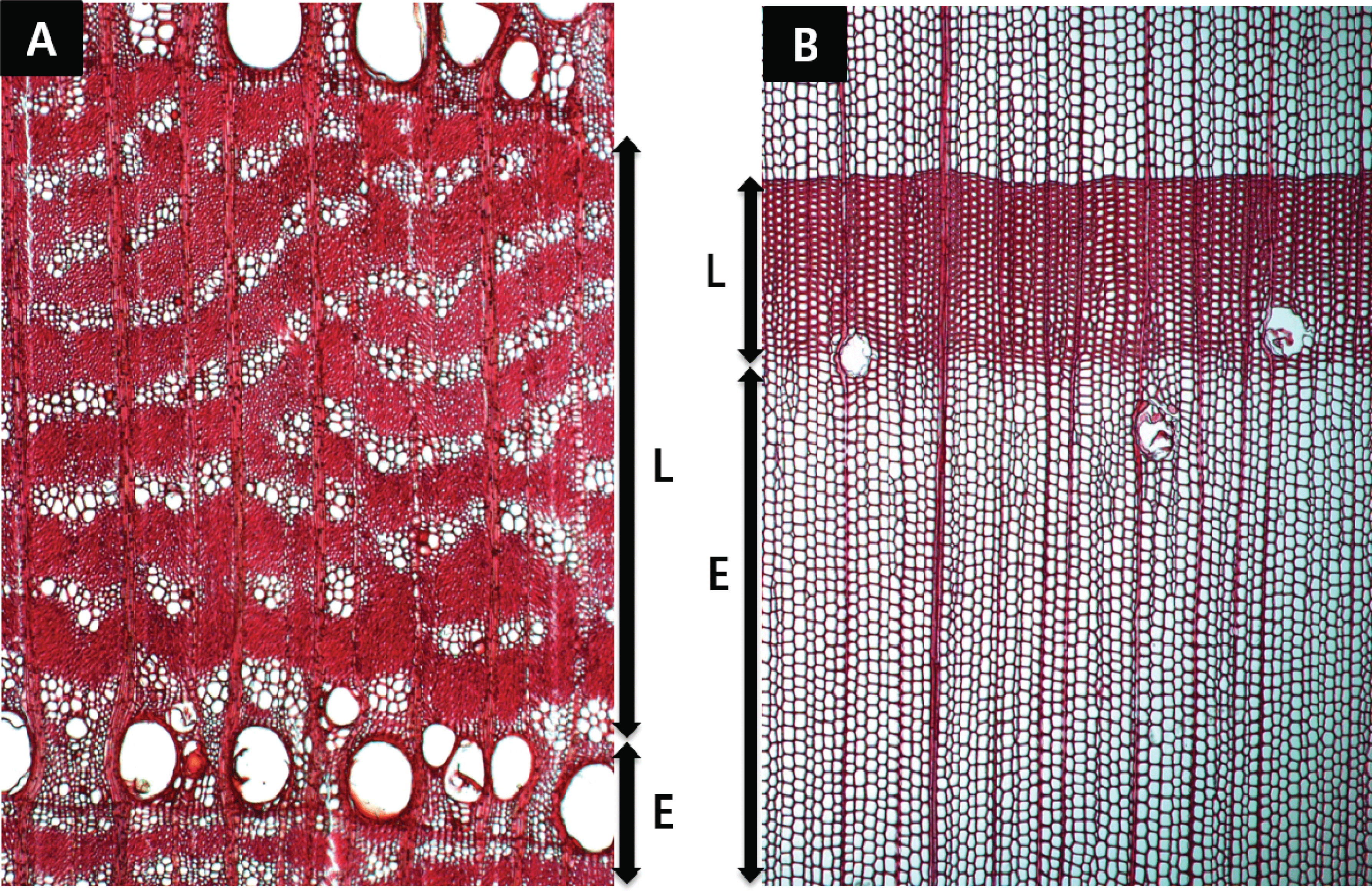
The ring-width time series established by electrical resistance measurement of resistography (PD-tool pro) were compared with the local master chronologies of Zelkova serrata and Pinus densiflora, established by Oh et al. (2017), to develop a time series using tree rings near the pith.
3. RESULTS and DISCUSSION
The most proper needle speed to determine tree-ring boundaries for the ring-width measurement was verified as 1500 r/min for both the tree species (Fig. 5). Whereas, the suitable feed speeds for Zelkova serrata and Pinus densiflora were 50 cm/min and 150 cm/min, respectively.
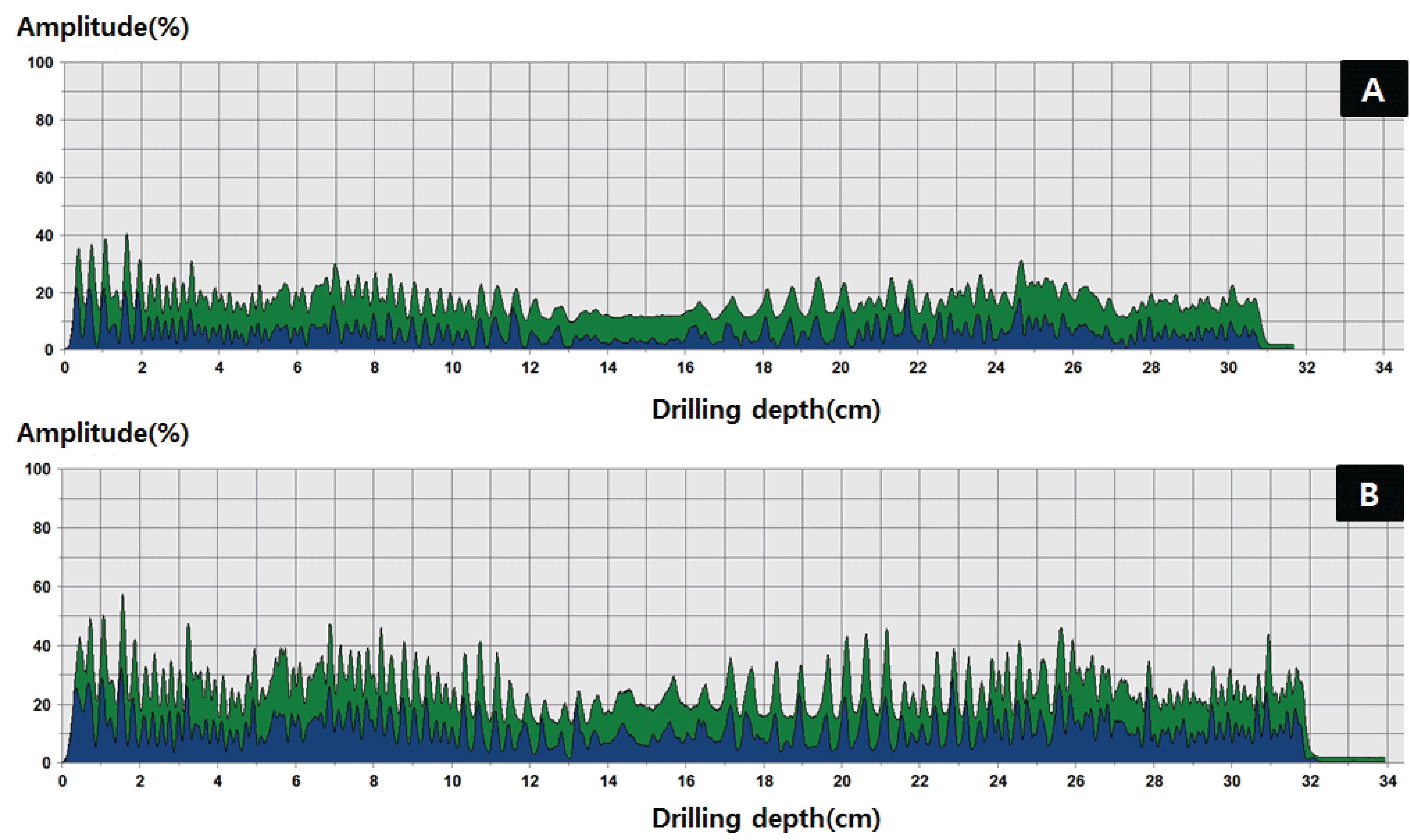
In the previous study (Oh et al., 2017), it was suggested that the most suitable needle speed to determine tree-ring boundaries in the measurement data was 1500 r/min for all the experimental tree species (Pinus koraiensis, Larix kaempferi, Pseudotsuga menziesii, Abies holophylla and Zelkova serrata), which was done using disks. In the current study, although resistograph was applied, the most suitable needle speed was also verified to be 1500 r/min. Based on these results, the needle speed of 1500 r/min might be the most proper option for measurement of tree-ring widths in general.
The feed speeds should be set differently depending on the density difference of the species(Frank, 1994). The feed speeds to determine tree-ring boundaries suggested by Oh et al. (2017) were different depending upon the tree species. The most suitable feed speed for Larix kaempferi and Pseudotsuga menziesii was 100 cm/min, for Pinus koraiensis 175 cm/min, for Abies holophylla 150 cm/min, and for Zelkova serrata 75 cm/min. In our study, however, the most suitable feed speed for Zelkova serrata was found to be 50 cm/min, different from the past report (Oh et al., 2017). Although there is no reference for Pinus densiflora, the proper feed speed for this tree was same as that of Abies holophylla, i.e. 150 cm/min. The differences of feed speeds between living trees and wood is due to different moisture content in the stems and disks (Bilgin et al., 2012).
As illustrated in Fig. 6 and 7, three tree-ring time series of 3 big old Zelkova serrata and 7 big old Pinus densiflra were established. The mean number of tree rings of Zelkova serrata and Pinus densiflora were 57 (43–68) and 104 (93-124) and the mean tree-ring widths were 4.27 mm (3.18-5.09 mm) and 2.93 mm (2.32-3.34 mm), respectively (Table 2 & 3).
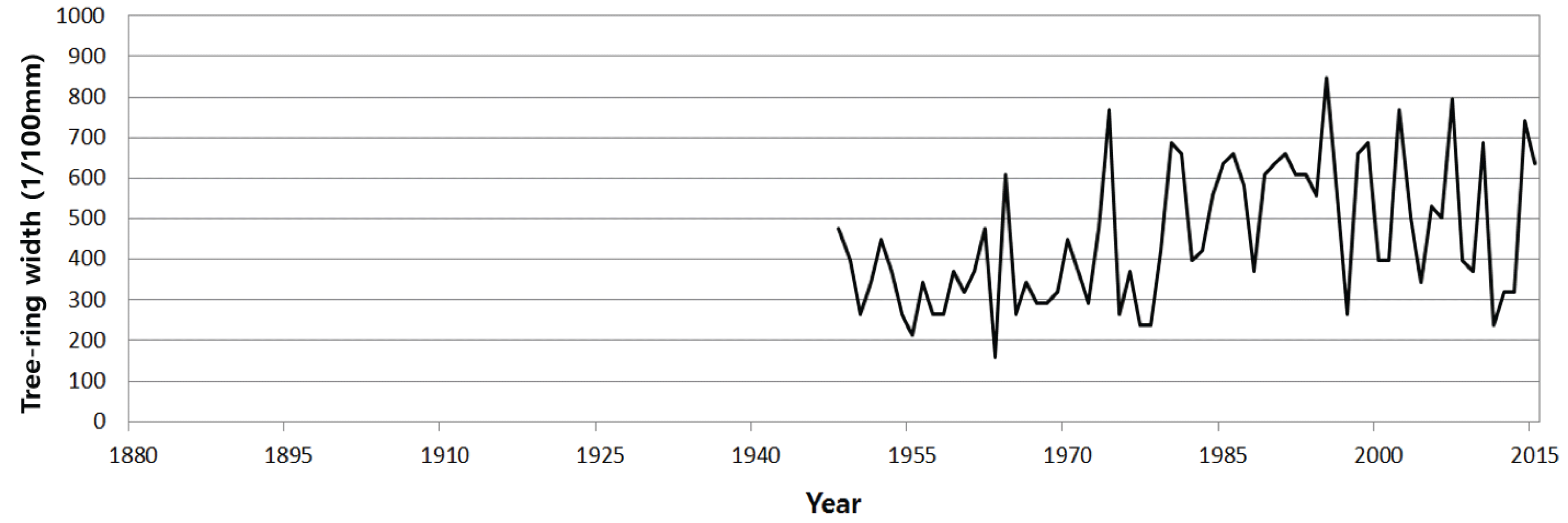
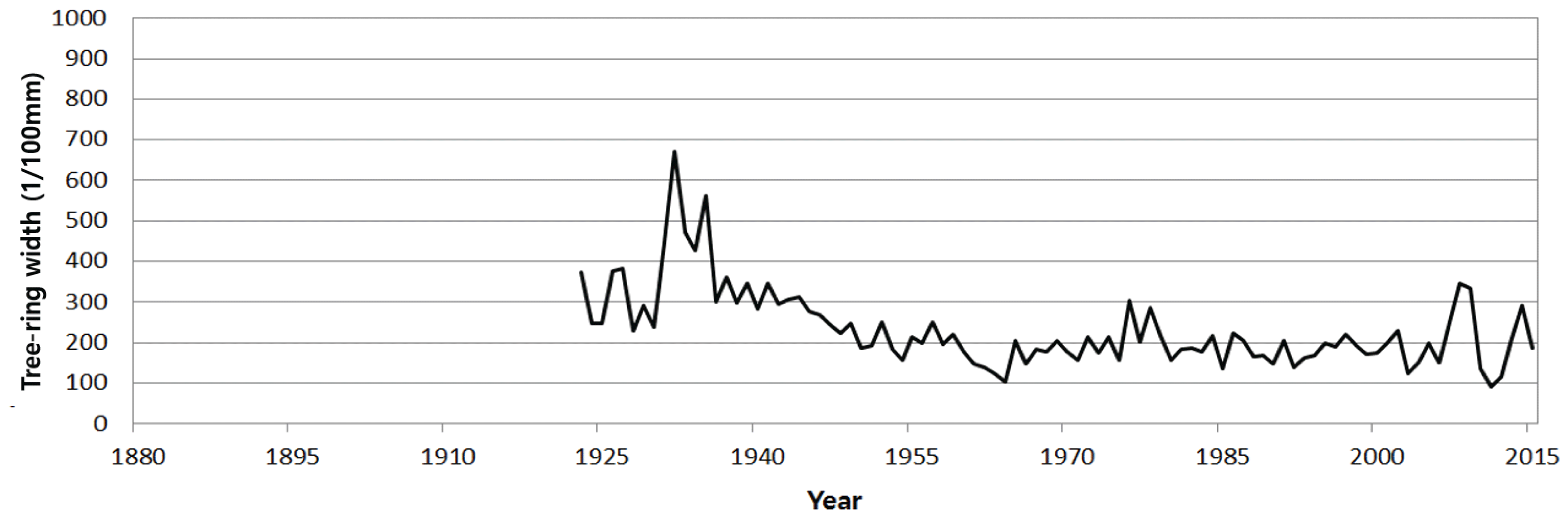
| ID | No. of measured direction | Number of tree rings | Tree-ring width (mm) | ||
|---|---|---|---|---|---|
| Minimum | Mean | Maximum | |||
| CBGSZS12 | 2 | 68 | 1.59 | 4.55 | 8.47 |
| CBGSZS13 | 1 | 43 | 1.59 | 3.18 | 6.35 |
| CBGSZS14 | 2 | 60 | 2.12 | 5.09 | 10.58 |
According to Oh et al. (2019), resistograph fails to measure tree-ring boundaries which are narrower than 1 mm. Therefore, the results showed differences between the number of tree rings observed in disks and those counted from the measurement data. Similarly, in the current study, the tree rings which are narrower than 1 mm will also not be well detected if the resistograph data are used. Therefore, the number of tree rings would be lower than the real existing tree rings. Especially, such errors would be more predominant in the sapwood due to aging effect (Schweingruber, 1988; Park 1993).
The tree rings in the sapwood are usually narrower than ones in the heartwood (Fig. 8 & 9). Therefore, the cross-dating technique was mostly applied to the tree rings in the heartwood for dating. By employing this strategy for cross-dating, the calendar year of the innermost tree rings could be successfully dated (Fig. 10). Therefore, the present study verified that the tree-ring time series by resistograph represent the real ring-width time series in the heartwood. To use resistograph to estimate the tree ages in other provinces, master chronologies, which are responsible for various tree species and provinces, need to be established.


4. CONCLUSION
To conclude, tree-ring time series for big old trees was established and tree-ring was dated. The most suitable needle speed to establish tree-ring time series for living big old Zekova serrata and Pinus densiflora using resistograph was 1500 r/min, whereas the most suitable feed speeds were 50 cm/min for the former and 150 cm/min for the latter. Although tree rings narrower than 1 mm and/or in the sapwood could not be well detected from the electrical measurement data of resistograph, it was verified that the tree rings in heartwood can be distinguished using the measured data. Therefore, the time series by resistograph can be dated with the available master chronology using the measurement data of tree-ring widths. Based on these results, we conclude that resistograph can be applied to estimate the age of trees located where a local master chronology is available.

